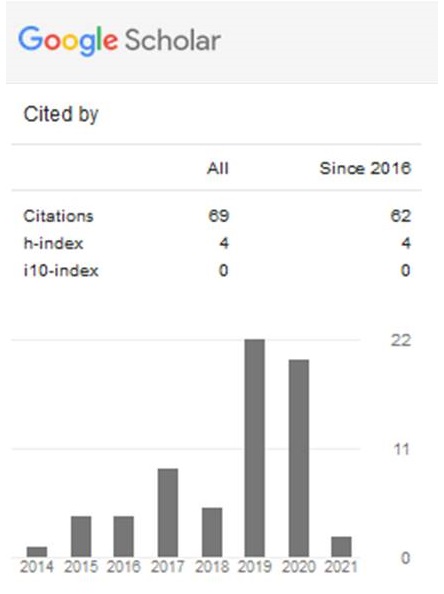Keragaman Makrofauna Tanah Pada Inceptisol yang Diaplikasi Berbagai Komposisi Mulsa Organik Dan Kepadatan Cacing Tanah Di Bawah Tegakan Tanaman Kelapa Sawit (Elaeis guineensis Jacq.)
Abstract
Oil palm plantations have become a profitable business, so that state, private and community plantation companies cultivate oil palm. The area of oil palm plantations in Riau Province in 2019 amounted to 2,806,349 ha. The suitable climate makes oil palm plants in Indonesia including in Riau cultivated on every type of soil available, most of which are acid mineral soils. Acid mineral soils have a wide distribution in wet tropical regions, including Indonesia. The total area of acid mineral soil in Indonesia is about 69.46% of the total land area in Indonesia. The purpose of this study was to determine the diversity of macrofauna applied to various organic mulch compositions and earthworm densities on Inseptisol soils under producing oil palm stands and to find out the best combination of organic mulch composition treatment with earthworm density that produces the highest macrofauna diversity. This research was conducted in a non-factorial experiment consisting of 6 treatments repeated 3 times each. Parameters observed were population density, relative density, diversity index (H`) and standard deviation. The data obtained from this study were then analyzed descriptively then the data results were presented in the form of tables. Giving some organic mulch composition and earthworm density produced 11 types of soil marofauna families (Termitidae, Formicidae, Lumbricidae, Achatinidae, Gryllidae, Blattidae, Carabidae, Chelisochidae, Eurymerodesmidae, Scolopendridae, Oniscidae). The highest diversity index (H`) value was in the M2 treatment (Mucuna bracteata: Empty palm bunches: Palm fronds =1:2:1).
Keywords
Full Text:
PDF (Bahasa Indonesia)References
Anwar, E.K. 2007. Pengaruh inokulan cacing tanah dan pemberian bahan organik terhadap kesuburan dan produktivitas Tanah Ultisol. J. Tanah Trop. 12 (2): 121-130.
Damayanti, E., A. Sofyan, H. Julendra dan T. Untari. 2009. Pemanfaatan Tepung Cacing Tanah ( Lumbricus rubellus) sebagai Agensia anti-pullorum dalam imbuhan pakan ayam boiler. Jurnal Ilmu Ternak Veteriner. 14(2): 83-89.
Hanafiah, K.A., A. Napoleon dan N. Ghofar. 2013. Biologi Tanah: Ekologi dan Mikrobiologi Tanah. Rajawali Pers. Jakarta
Hilwan, I. Dan E.P. Handayani. 2013. Keanekaragaman Mesofauna dan Makrofauna Tanah pada Areal Bekas Tambang Timah di Kabupaten Belitung, Provinsi Kepulauan Bangka-Belitung. Jurnal Silvikultur Tropika. 4 (1) : 35-41.
Kementerian Pertanian .2012. Statistik Pertanian 2012. Kementerian Pertanian. Jakarta.
Kementerian Pertanian. 2019. Luas Areal Kelapa Sawit Menurut Provinsi di Indonesia, 2015-2019 (Palm Oil Area by Province in Indonesia). https://www.pertanian.go.id/home/index.php?show=repo&fileNum=229,
Keknusa, J.S. 1993. Pola penyebaran, keanekaragaman dan asosiasi antar spesies teripang di perairan pantai barat Pulau Nain, Sulawesi Utara. Jurnal Fakultas Perikanan Universitas Samratulangi. Volume 11(4):11-17
Puslittanak. 2000. Atlas Sumberdaya Tanah Eksplorasi Indonesia skala 1: 1.000.000. Puslittanak, Badan Litbang Pertanian. Bogor.
Ruiz, N., P. Lavelle, and J. Jimenez. 2008. Soil Macrofauna Field Manual. Food and Agriculture Organization of the United Nations.
Rome Sabrina, D.T., M.M. Hanafi, A.A. NorAzwady and T.M.M. Mahmud. 2009. Earthworm populations and cast properties in the soils of oil palm plantations. Malaysian Journal of Soil Sciencen. 13: 29-42.
Sirait, B. A. 2010. Keanekaragaman Fauna Tanah dan Perannya Terhadap Laju Dekomposisi Serasah Kelapa Sawit (Elaeis guineensis Jacq). Skripsi. Fakultas Kehutanan. Institut Pertanian Borgor.
Soil Survey Staff, 2010. Key To Soil Taxonomy. ED Ke-II. USDA, Natural resources Concervation service. 161-196p.
Wawan, Anthony dan Sukemi. 2019. Pengelolaan lahan mineral masam berkelanjutan untuk produksi kelapa sawit melalui aplikasi mulsa organik dan cacing tanah. Faperta Universitas Riau. Pekanbaru.
Refbacks
- There are currently no refbacks.

_2017.jpg)



